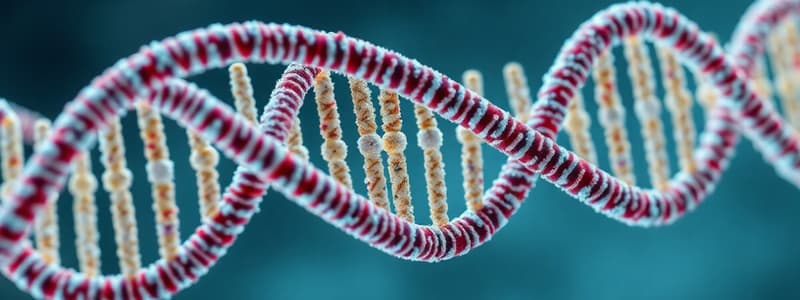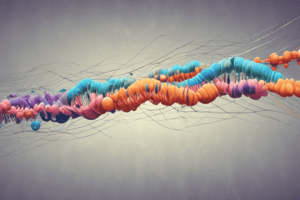Podcast
Questions and Answers
What is the main characteristic of highly repetitive sequences in a genome?
What is the main characteristic of highly repetitive sequences in a genome?
- They are involved in transposon mobility across the genome.
- They consist of functional genes essential for survival.
- They are single-copy sequences spread throughout the genome.
- They contain multiple copies, such as satellite DNA. (correct)
In the structure of prokaryotic chromosomes, what role does DNA gyrase play?
In the structure of prokaryotic chromosomes, what role does DNA gyrase play?
- It assists in the compaction of chromatin.
- It introduces positive supercoiling in DNA.
- It creates looped domains in bacterial DNA.
- It induces negative supercoiling to aid replication and transcription. (correct)
Which of the following correctly distinguishes constitutive from facultative heterochromatin?
Which of the following correctly distinguishes constitutive from facultative heterochromatin?
- Constitutive heterochromatin is involved in gene expression, while facultative heterochromatin remains inactive.
- Facultative heterochromatin is always compacted, while constitutive heterochromatin is transcriptionally active.
- Facultative heterochromatin is permanently condensed, contrasting with the dynamic nature of constitutive heterochromatin.
- Constitutive heterochromatin is found in centromeres, while facultative heterochromatin can change its locations within the genome. (correct)
What feature of eukaryotic chromosomes contributes to their compact structure?
What feature of eukaryotic chromosomes contributes to their compact structure?
Which process is primarily responsible for the compaction of DNA into looped domains in eukaryotic chromosomes?
Which process is primarily responsible for the compaction of DNA into looped domains in eukaryotic chromosomes?
During which stage of cell division is chromosomal compaction maximized?
During which stage of cell division is chromosomal compaction maximized?
What best describes the C-Value Paradox?
What best describes the C-Value Paradox?
What type of chromatin is primarily responsible for transcriptional activity?
What type of chromatin is primarily responsible for transcriptional activity?
Which statement accurately describes the function of topoisomerases in DNA compaction?
Which statement accurately describes the function of topoisomerases in DNA compaction?
What distinguishes tandem repeats from other types of repetitive sequences?
What distinguishes tandem repeats from other types of repetitive sequences?
How does negative supercoiling benefit bacterial DNA during replication and transcription?
How does negative supercoiling benefit bacterial DNA during replication and transcription?
What primarily influences the transition between euchromatin and heterochromatin states?
What primarily influences the transition between euchromatin and heterochromatin states?
Which of the following best describes the nature of constitutive heterochromatin?
Which of the following best describes the nature of constitutive heterochromatin?
What role does the CTCF protein play in chromosome structure?
What role does the CTCF protein play in chromosome structure?
What mechanism is involved in the relaxation of positive supercoiling in bacterial DNA?
What mechanism is involved in the relaxation of positive supercoiling in bacterial DNA?
Which level of chromosomal structure is achieved after the formation of the 30 nm fiber?
Which level of chromosomal structure is achieved after the formation of the 30 nm fiber?
What phenomenon describes the lack of correlation between genome size and organismal complexity?
What phenomenon describes the lack of correlation between genome size and organismal complexity?
What primarily characterizes moderately repetitive sequences in the genome?
What primarily characterizes moderately repetitive sequences in the genome?
Flashcards
Genome
Genome
The complete set of genetic material in an organism.
Transposable Element
Transposable Element
A DNA sequence that can move within a genome.
C-Value Paradox
C-Value Paradox
Genome size doesn't always correlate with organism complexity.
Chromosome
Chromosome
Signup and view all the flashcards
Negative Supercoiling
Negative Supercoiling
Signup and view all the flashcards
Nucleosome
Nucleosome
Signup and view all the flashcards
Heterochromatin
Heterochromatin
Signup and view all the flashcards
Euchromatin
Euchromatin
Signup and view all the flashcards
Metaphase Chromosome
Metaphase Chromosome
Signup and view all the flashcards
Repetitive Sequences
Repetitive Sequences
Signup and view all the flashcards
Satellite DNA
Satellite DNA
Signup and view all the flashcards
rRNA Genes
rRNA Genes
Signup and view all the flashcards
Alu Elements
Alu Elements
Signup and view all the flashcards
DNA Gyrase
DNA Gyrase
Signup and view all the flashcards
NAPs (Nucleoid-Associated Proteins)
NAPs (Nucleoid-Associated Proteins)
Signup and view all the flashcards
Histones
Histones
Signup and view all the flashcards
Constitutive Heterochromatin
Constitutive Heterochromatin
Signup and view all the flashcards
Facultative Heterochromatin
Facultative Heterochromatin
Signup and view all the flashcards
Study Notes
Genome Structure
- Genome: The complete set of genetic material in an organism, composed of nucleotides.
- Transposable Elements: DNA sequences that can move within the genome ("jumping genes").
- C-Value Paradox: Genome size does not consistently correlate with organism complexity.
- Repetitive Sequences: Varying copy numbers and functions within the genome
- Highly Repetitive: Multiple copies of short sequences (satellite DNA).
- Moderately Repetitive: Functional sequences, like rRNA genes, present in multiple copies.
- Tandem Repeats: Short sequences repeated in succession (Alu elements).
Chromosome Structure and Compaction
Bacterial Chromosome
- Compaction by supercoiling.
- Negative Supercoiling: DNA is unwound (left-handed twist) by DNA gyrase (Topoisomerase II), essential for replication and transcription.
- Positive Supercoiling: DNA is overwound (right-handed twist), relaxed by Topoisomerase I.
- Looped Domains: Organized into microdomains and macrodomains by Nucleoid-associated proteins (NAPs).
Eukaryotic Chromosome
- Chromatin: DNA-protein complex, packing material for DNA.
- Euchromatin: Less condensed, active in transcription.
- Heterochromatin: Highly condensed, inactive in transcription.
- Constitutive Heterochromatin: Always condensed, found at centromeres.
- Facultative Heterochromatin: Variable, location can change.
Chromosome Compaction Process
-
DNA Double Helix: The basic structure of DNA.
-
Nucleosome: DNA wrapped around histone proteins (like "beads on a string").
-
Zigzag/30 nm Fiber: Further compaction of nucleosomes.
-
Looped Domains: Formation of large loops involving CTCF and SMC proteins.
-
Heterochromatin: Further compaction of looped domains.
-
Metaphase Chromosome: The most compacted form of a chromosome, achieved during cell division.
Studying That Suits You
Use AI to generate personalized quizzes and flashcards to suit your learning preferences.



